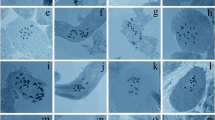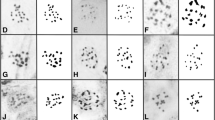Summary
-
1.
Chromosome numbers of 32 species from 13 genera representing three of the four tribes of the Malvaceae are reported. They are summarized in Table 1 (p. 433).
-
2.
It is possible to identify certain of the chromosomes of the diploid species ofAbutilon by characteristic features of their morphology.
-
3.
Attachment of chromosomes to the nucleolus in the prophase of mitosis or meiosis has been observed in several genera, especiallyAbutilon andSidalcea.
-
4.
Secondary association probably occurs in most polyploid species examined, but is not pronounced.
-
5.
Tetraploid strains occur in severalHibiscus species.
-
6.
Of three races ofAnoda cristata L., two had the haploid number 15, while the third had n=18. The problem of the origin of such variant strains is discussed.
-
7.
It is concluded that 7 is the basic number in theMalveae andUreneae, and probably also in theMalopeae. The basic number in theHibisceae is as yet uncertain, though the evidence is not incompatible with b=7 as in the Malveae and Ureneae.
Similar content being viewed by others
References
Alam, Z. (1936). “Cytological studies of some Indian oleiferous Cruciferae. III”. Ann. Botany 50: 85–102.
Arutjunova, L. G. (1936). “An investigation of chromosome morphology in the genusGossypium”. Compt. Rend. Acad. Sci. USSR. 3 (12): 37–40.
Banerji, J. (1929). “The chromosome numbers of Indian cottons”. Ann. Botany 43: 604–607.
Blackburn, K. B. (1933). “On the relation between geographic races and polyploidy inSilene ciliata Pourr”. Genetica 15: 49–66.
Breslavetz, L., Medwedewa, G., andM. Magitt. (1934). “Zytologische Untersuchungen der Bastpflanzen”. Z. Zücht. 19: 239–2.
Burkett, G. W. (1932). “Chromosome numbers inAlthaea rosea”. Science 75: 488.
Catcheside, D. G., (1934). “The chromosomal relationships in the swede and turnip groups ofBrassica”. Ann. Botany 48: 601–633.
Davie, J. H. (1933). “Cytological studies in the Malvaceae and certain related families”. J. Genetics 28: 33–67.
Davie, J. H., (1935). “Chromosome studies in the Malvaceae and certain related families. II. Genetica 17: 487–498.
Denham, J. H. (1924a). “The cytology of the cotton plant. I. Microspore formation in Sea Island cotton”. Ann. Botany 38: 407–432.
Denham, H. J., (1924b). “The cytology of the cotton plant. II. Chromosome numbers of Old and New World cottons”. Ann. Botany 38: 433–438.
Gates, R. R. (1935). “Symbols for chromosome numbers”. Nature 85: 188.
Kesseler, E. von (1932). “Observations on chromosome number inAlthaea rosea, Callirhoe involucrata, andHibiscus coccineus”. Am. J. Bot. 19: 28–30.
Krenke, P. (1929). Cited fromG. Tischler. (1931). Tabulae Biologicae Periodicae, 7: 158.
Kuhn, E. (1930). Cited fromG. Tischler. (1931). Tabulae Biologicae Periodicae 7: 188.
La Cour, L. (1931). “Improvements in everyday technique in plant cytology”. J. Roy. Micros. Soc. 51: 119–126.
Latter, J. (1932). “The meiotic divisions in pollen mother cells ofMalva sylvestris”. Ann. Botany 46: 1–10.
Lawrence, W. J. C. (1931). “The secondary association of chromosomes”. Cytologia 2: 351–384.
Longley, A. E. (1933). “Chromosomes inGossypium and related genera”. J. Agric. Res. 46: 217–227.
Margadant (1926). Cited fromG. Tischler. (1927). Tabulae Biologicae Periodicae 4: 36.
Muntzing, A. (1935). “Chromosome behaviour in some Nicotiana hybrids”. Hereditas 20: 251–272.
Nakajima, G. (1936). “Chromosome numbers in some crops and wild angiosperms”. Jap. J. Genetics 12: 211–218.
Navashin, M. (1932). “The dislocation hypothesis of evolution of chromosome numbers”. Z.I.A.V. 53: 224–231.
Randolph, L. F. (1928). “Types of supernumerary chromosomes in Maize”. Anat. Record 41: 102.
Skovsted, A. (1934). “Cytological studies in cotton. II. Two interspecific hybrids between Asiatic and New World cottons”. J. Genetics 28: 407–424.
Skovsted, A. (1935). “Chromosome numbers in the Malvaceae. I”. J. Genetics 31: 263–296.
Skovsted, A. (1937). “Cytological studies in Cotton. IV. Chromosome conjugation in interspecific hybrids”. Journ. of Genetics 34: 97–133.
Svenssen-Stenar, A. H. (1925). “Embryologische Studien. I. Zur Embryologie einer Columniferen.” Akad. Aflr. Uppsala, pp. 1–75.
Teshima, T. (1933). “Genetical and cytological studies on an interspecific hybrid ofHibiscus esculentus L. andH. Manihot L.” J. Fac. Agr. Hokkaido Univ. 34: 155.
Webber, J. M. (1934). “Chromosome number and meiotic behaviour inGossypium”. J. Agr. Res. 49: 223–237.
Webber, J. M. (1936). “Chromosomes inSphaeralcea and related genera”. Cytologia 7: 313–323.
Author information
Authors and Affiliations
Rights and permissions
About this article
Cite this article
Ford, C.E. A contribution to a cytogenetical survey of the Malvaceae. Genetica 20, 431–452 (1938). https://doi.org/10.1007/BF01531777
Received:
Issue Date:
DOI: https://doi.org/10.1007/BF01531777




